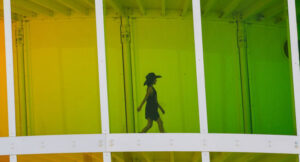I drove home at midnight on Saturday through thunder and lightning, that stretched from horizon to horizon like a scene from the end of the world. The mood was made eerier by having eaten dinner outdoors, a scant few miles away, on a patio somehow unvisited by this howling storm.
There, the conversation touched on a book heralding the return of enchantment, terror, and awe to the world. And as the sky seemed to tear around me, it was as if that uncanny feeling of the world’s aliveness was suddenly all around me.
Cocooned in my warm, dry car, it felt exhilarating: insulated from the wild elements by my mechanical bubble. But that sense of engineered safety has, at a broader level, grown shakier recently – not least because there have been more wild elements about than usual. The weekend’s rain prompted flood warnings across England, and by Monday homes, streets, and cars were flooded. Schools, roads, and train routes were closed. There was even a ‘mini-tornado’ in Luton.
Is our weather getting more uncanny? The press thinks so: it’s as though we want it to be getting worse. A chilly spell in summer is “the coldest on record”; a wet month “the wettest”. Headlines about “extreme” weather are common, while you have to read more than halfway down the Met Office’s page on “extreme rainfall” in the UK to discover that this is “within past natural variation”.
In other words: in keeping with the usual British climate, nothing is still happening, changeably, and with lots of precipitation. But even business more or less as usual has become a dread omen: “Never-ending rain” is now promised as our winter future – and not just any old rain but “20% wetter” rain. Even small variations in temperature merit panicky headlines: earlier this year there was great merriment in India after the Mirror warned of a “heatwave” rising as high as 26 degrees, which for a subcontinent accustomed to ambient temperatures well above 40 might mean putting on a cardigan.
There’s some justice to the sniggering. The defining feature of our climate is that while it’s sometimes unkind to picnickers or cricket-lovers, it’s rarely aggressively hostile. The worst it’s conventionally likely to do is bore us to distraction, through yet another miserable winter afternoon. Following his first visit to England in 1955, the Bengali writer Nirad Chaudhuri concluded that the English must derive their characteristically even temper from this changeable but mild climate – not least because, he observed, once transplanted to the stark heat of the subcontinent that serenity swiftly soured into a far more unpleasant ill-temper.
The historian Robert Winder made a similar case more recently, arguing in The Last Wolf (2017) that beyond anything else, the English are the way they are because of the landscape and weather. And yet, wonders Paul Kingsnorth in response: is that still true? Certainly, the derision that greeted Robert Jenrick for invoking “English identity” recently suggests we’re no longer quite as sure who we are. And if Kingsnorth is right, this uncertainty may be connected to our relative insulation from climate and landscape.
Certainly, meeting thunder and lightning in the chilly, hand-to-mouth world of Bronze and Iron Age Britain must have been awe-inspiring and frightening in equal measure. No wonder the ancient Celts would burn human sacrifices to propitiate Taranis, the god of thunder and lightning. And in Anglo-Saxon Britain Þunor, a fierce god whose rumbling carriage wheels made the thunder, was so widely venerated he was often specifically named in baptismal vows as one of the deities being renounced.
It’s not difficult to imagine that the confrontation with climate you’d experience in mostly un-heated and far less waterproof Bronze Age England would help shape both individual characters, and the culture of wider communities in that environment By contrast, while I enjoyed the midnight thunderstorm over East Anglia, I remained largely cut off from it. It felt thrilling, but not overwhelming.
When I think of traditional English foods, clothing, and festivals, many of these (such as stodgy puddings) only make sense if you live largely outdoors and your home has no central heating. So perhaps Kingsnorth is right, and the great enemy of national identity is really modernity and its technologies, in the many ways these uproot us from the spirit of a place and climate. And yet, paradoxically, it’s this same arc of modernity which is now conjuring the weather gods back into the world today.
Whether it’s caused by gods, fairies, or climate change, chaotic weather spells catastrophe for farming cultures. Over four centuries ago, Shakespeare’s A Midsummer Night’s Dream captured that sense of deep unease:
“…The spring, the summer,
The childing autumn, angry winter change
Their wonted liveries, and the mazèd world,
By their increase, now knows not which is which.”
Perhaps more than any other English literary figure, Shakespeare had one foot in the medieval world and one in early modernity. In the centuries that followed him, science and technology marched relentlessly on, driving back the weather gods — and even the fairies — while advancing our control over and protection from our environment. In its wake the world has grown a great deal more comfortable; but the price was what the philosopher Charles Taylor calls “disenchantment”: the loss of magic and mystery from the world, replaced with a more banal universe of legibility and mastery. Even A Midsummer Night’s Dream we can see that slow retreat of enchantment: here, climate chaos is not — as it was for the Celts — a frightening reality that prompts human sacrifice, but a jolly device in a play, caused by fairies quarrelling.
Modernity, then, disenchanted the world by controlling it through technology. Now, though, four centuries further into that arc of discovery and power, the weather gods are back — but this time as byproducts of modernity: first with the reported threat of climate change, and secondly thanks to the power of big data to visualise these changes.
Today, those charts and visualisations are at everyone’s fingertips, in our ubiquitous smartphones. There’s even an app called “Weather Gods” that promises to “immerse” me in climate data with graphs, sounds, and cute personifications of the elements. It grants an illusion of control over the weather — but, in practice, all I actually get is slightly more precise guidance on whether I should take an umbrella with me than I’d get from looking at the sky and making a judgement call. The same also goes for all the charts and graphs which support the torrent of dire warnings about the effect modernity itself is having, in aggregate, on the weather. No matter how many warnings or calls to action are published, emissions go on rising.
And this is because both the weather, and aggregate human consumption, are types of complex and self-propelling dynamic systems that we can see, thanks to measurement and data visualisation, but which remain radically resistant to influence. In other words: exactly the kind of mysterious force that earlier times might have personified as a god or demon.
Of course, after four centuries of disenchantment we’re out of the habit of using such a florid term as “god” or “demon”. And yet, for all that we’re having the conversation in a “sciencey” register instead, with charts and computer models and so on, the subtext is still closer to the ancient Celts’ relation to the sky. What it expresses is a deep fear that we’re making the weather gods angry: a fear now so widespread it pervades the public conversation even in a temperate country where nothing much really has changed about the weather.
In the light of this fear, we notice every little blip, each of which is now documented, measured, tabulated and pored over as possible evidence of “climate change”. And it’s not so much that the weather is worse than usual, but that we are expecting it to be worse, because a larger narrative about excess, greed, overreach and vengeful gods has told us it’s going to be. If it’s ironic that our modern lifestyles are conjuring their retribution, it’s even more ironic that the sciencey stuff is itself now encouraging us to see the climate in these terms, as a vengeful deity.
Whereas ancient peoples made gods of the weather in the absence of information, we are re-awakening these gods as a byproduct of too much. And what these ancient and post-modern forms of weather god have in common is the sense of powerlessness, awe, and fear that comes with confronting the presence of forces greater than us: in a word, re-enchantment.
We might, perhaps, find the presence of these figures easier to bear if we were willing to acknowledge them more directly. For it is growing apparent that “disenchantment” was the dream all along. It was an effect of the illusion that we were ever in control: an illusion the weather gods can shatter at will, with a single thunderbolt.
Disclaimer
Some of the posts we share are controversial and we do not necessarily agree with them in the whole extend. Sometimes we agree with the content or part of it but we do not agree with the narration or language. Nevertheless we find them somehow interesting, valuable and/or informative or we share them, because we strongly believe in freedom of speech, free press and journalism. We strongly encourage you to have a critical approach to all the content, do your own research and analysis to build your own opinion.
We would be glad to have your feedback.
Source: UnHerd Read the original article here: https://unherd.com/




